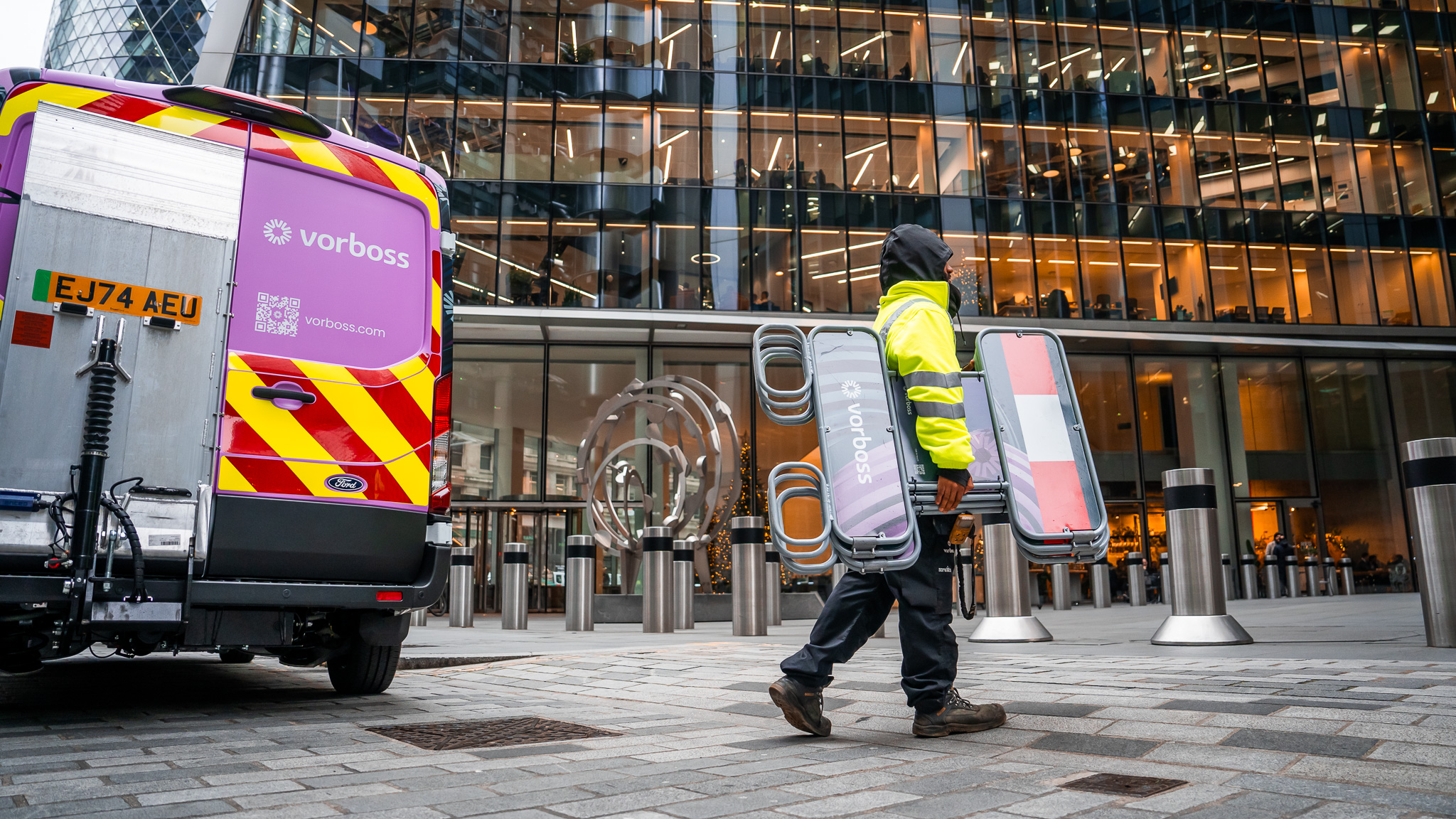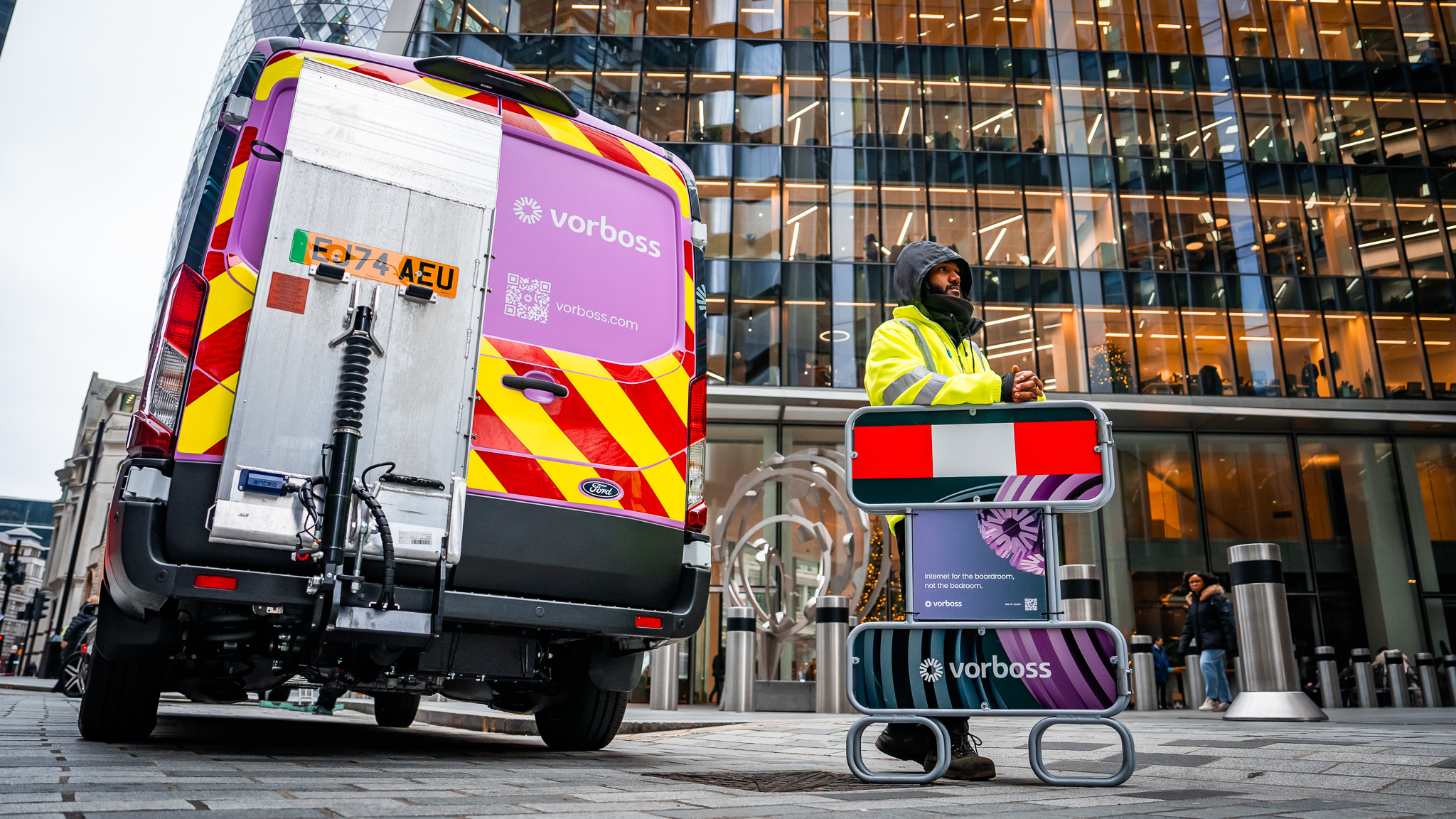Fibre internet options for business: FTTC, FTTP, and DIA explained
July 8, 2025
|
5
min read

Highlights
Is your business broadband really what you signed up for? If video calls lag or uploads drag, your connection might not be what you expected. In this blog, we break down FTTC, FTTP, and DIA - three ‘fibre’ options with very different performance and stability.
If you run a business in the UK, you’ve probably heard the term ‘fibre broadband’. But fibre comes in different forms, and not every connection delivers the same speed, reliability, or consistency. Broadband is one common option, but businesses can also choose dedicated fibre connections, like Direct Internet Access (DIA), sometimes called a leased line, that are built specifically for high-performance, reliable business use.
Understanding the differences between these connection types is key to making sure your internet keeps up with your team and growth.
Quick glossary
- FTTC (Fibre to the Cabinet): Fibre runs to a street cabinet, then copper lines carry it to your building. Speeds can be slow and fluctuate because the connection is shared.
- FTTP (Fibre to the Premises): Full fibre to your building, offering faster and more stable speeds than FTTC, but still shared with other users.
- Direct Internet Access (DIA/Leased Line): A dedicated fibre connection just for your business, with guaranteed symmetrical speeds and high-availability uptime.
FTTC (fibre to the cabinet): fibre, kind of
.jpg)
FTTC runs fibre from your provider’s network to a street cabinet near you, then uses copper wires to reach your premises (while still selling you ‘fibre’).
Copper = outdated. Which means slower speeds, interference, and fluctuating performance – especially if the cabinet’s a few blocks away or shared by lots of users. And those cabinets? They’re exposed to weather and vandalism, adding yet another layer of risk.
Who is FTTC for?
FTTC might work for casual browsing, but if your business depends on video calls, cloud platforms, or remote collaboration, expect slow uploads, dropped connections, and no guarantees when things go wrong.
FTTP (fibre to the premises): better, but still shared
.avif)
Unlike FTTC, FTTP is a fibre connection that runs straight from the exchange to your building. With no copper cabling involved, it offers better speed and stability.
But here’s the catch: while this is often what internet service providers call ‘business broadband’, you still share your connection with up to 30 others. And while the average speed range is typically quoted as 150 to 900Mbps, the reality is, you often won't always experience those speeds, particularly during peak times because you share your bandwidth with others.
Who is FTTP for?
For micro businesses or early-stage start-ups, FTTP may provide a half workable solution, especially as a stepping stone. But be prepared for pixelated, laggy video calls or a long wait to download a pitch deck during busy times and sometimes, for no apparent reason at all.
As we put it in our earlier blog comparing broadband to leased lines: ‘If it’s broadband, it’s shared’. FTTP is still broadband and not something that provides a genuine solution for reliable connectivity.
What to be aware of if you are considering buying FTTP
FTTP can sound a lot like a high-end business service. It’s full fibre. It promises impressive speeds. And it often comes with confident-sounding terms like ‘uptime guarantee’ or ‘symmetrical speeds’. But these features deserve a closer look, because what they offer in theory isn’t always what they deliver in practice.
Take ‘symmetrical speeds’. FTTP can technically offer equal upload and download speeds, but only if the network isn’t busy and your plan allows it. Most of the time, upload speeds drop off when everyone’s online.
Then there’s the ‘uptime guarantee’. Sounds great. But without automatic compensation for downtime or real SLAs, they're often just marketing phrases – not a sign of real accountability. Many providers only commit to a response or investigation window, rather than to actual fix times.
Other elements that sound impressive but don’t necessarily reflect business grade standards. Static IP addresses are promoted as a ‘business’ feature, but these are widely available as standard on home broadband. ‘Priority fault handling’ usually just means you’re ahead of domestic users - not first in line for a fix.
So, while FTTP is better than FTTC, it is still very much part of that ‘broadband’ family. It’s a strong consumer-grade product, but not a substitute for a business-grade connection.
FTTC vs FTTP: How to tell what connection you have
Many businesses get sold 'broadband' without knowing the type of fibre connection. Here’s how to check:
- Check your provider’s plan documents or welcome email – it often states FTTC or FTTP.
- Ask your provider directly – they can confirm whether your line is full fibre (FTTP) or fibre to the cabinet (FTTC).
Knowing which connection you have matters because FTTC and FTTP have very different speeds, reliability, and suitability for business workloads.
Direct internet access (DIA): fibre built for business
.jpg)
DIA, sometimes known as a ‘leased line’ or ‘dedicated internet’, is a full fibre connection exclusively allocated to a single business. Unlike FTTC or FTTP, it isn’t shared with neighbouring offices or homes, and it isn’t affected by the demands of other users on the network.
It’s your own, dedicated connection, built for performance, reliability, and security.
With DIA, you always get ‘actual’ symmetrical speeds, meaning your uploads are just as fast as your downloads. This makes a big difference for real-time communication, file transfers, and cloud tools. You also benefit from 1:1 contention, meaning your bandwidth is always your own and performance doesn’t drop at peak times - because there’s no one else on your line.
Most importantly, DIA comes with robust service-level agreements (SLAs). These go beyond vague promises, offering clear commitments on uptime guarantees, target fix times, and - with a good provider - automatic compensation if things go wrong.
It’s not just about speed; it’s about having trust in the service that underpins your operations.
Who is DIA for?
- Teams that rely on cloud-heavy workflows: platforms like Salesforce, Azure, AWS, or cloud CRMs need reliable 24/7 access. Outages or slow speeds mean lost hours and lost business.
- Creative and media teams: agencies and production houses transferring large design files or uploading media to the cloud need fast, stable upload speeds. DIA’s symmetrical performance makes that possible.
- Security-focused organisations: if your business runs VPNs, firewalls, or handles sensitive data, you need a connection that supports uptime and compliance without compromise.
- Hybrid/remote teams: distributed workforces need reliable video calls, collaboration tools, and seamless file sharing. DIA keeps everyone connected – consistently.
FTTC vs FTTP vs DIA: the differences that matter for London businesses
Choosing the right internet connection for your business
FTTC, FTTP and DIA each have their place, but they’re not interchangeable. Unfortunately for many businesses, the differences become visible the moment the connection is put under pressure.
For businesses in this day and age, FTTP and FTTC are not fit for purpose. And being overly reliant on outdated infrastructure costs London businesses billions a year in outages.
DIA (whether you call it a leased line or dedicated internet) is designed with business in mind. For teams working in the cloud, relying on uptime or collaborating in real time, it offers a level of confidence that shared broadband simply can’t match.
Choose with care. The best internet solution is the one that will support the way your business works not only now, but also as it grows.
If you want to find out if DIA is right for your business, get in touch with our team. We're always happy to chat through your options.
Tell us about yourself so we can serve you best.
Got a question?
More articles

For many landlords and building managers, the word “wayleave” feels like the responsible route whenever a fibre circuit is being installed on their property. It sounds formal and safe – a neat legal box to tick.
In many cases, however, a wayleave adds unnecessary complexity and delays, frustrates tenants, and can expose landlords to long-term legal risks.
At Vorboss, we’ve connected thousands of office spaces across London without a wayleave, keeping landlords in full control and getting tenants online faster.

What is a wayleave?
A wayleave is a written agreement between a landowner and a telecoms operator. It gives the operator permission to install and keep equipment on private property.
What many people don’t realise is that signing a wayleave also activates “Code rights” under the Electronic Communications Code. These rights go beyond simple permission, they give the operator legal powers to stay on the property indefinitely, access it when needed, and even refuse removal of their equipment in certain situations.
For a typical connection into a commercial building in London, a wayleave can make the fibre installation process slower, more expensive, and limit the landlord’s flexibility long term.
Why a wayleave isn’t required for standard in-building fibre connections
For a standard in-building fibre connection serving a tenant, a wayleave isn’t a legal requirement. Important protections, like building access, fire safety, repairing any damage, and removing equipment, are already covered by the tenant’s lease and usual building rules.
If no wayleave is signed, no Code rights are triggered, meaning the landlord retains full control and the installation exists under a simple, fully revocable licence.
In practice, this gives landlords far more protection and flexibility:
- No legal lock-in – the telecoms operator has no long-term rights to stay or refuse removal.
- Landlords keep full control – equipment can be moved or removed when the building changes.
- Faster fibre installation – no time lost in drafting contracts or solicitor reviews.
- Happier tenants – connections go live quicker; tenants get to move in faster.
By contrast, signing a wayleave and granting Code rights introduces a complex and expensive legal process for any fibre removal or relocation. This can take at least 18 months, plus potential court or tribunal proceedings, making it slower, and far less flexible for the landlord.

Public services across central London are evolving, and the City of London Corporation is leading the way.
Whether you work, live or study in the Square Mile, you’ll soon feel the difference that faster, more dependable connectivity brings.

What is the Future Network Programme?
The City of London Corporation is rolling out the Future Network Programme, a major project to modernise its entire digital infrastructure and bring everything under one unified network.
From offices and schools to iconic green spaces like Hampstead Heath, cultural destinations like the Barbican, and historic markets such as Leadenhall and Old Spitalfields, this upgrade will mean more reliable connectivity across the City’s buildings and public spaces.
It also extends to essential services, including critical sites run by the City of London Police. This enhanced connectivity will support everything from secure communication systems to faster, more resilient networks for emergency operations.
Leading this transformation is Roc Technologies, supported by Juniper Networks and Palo Alto Networks; all powered by the Vorboss fibre network. Together, we’re bringing the City onto a modern digital foundation that’s ready to support its future.
Who the Future Network Programme benefits and how?
The programme is designed for everyone who depends on public services in the Square Mile:
- Students in City-run schools will have fast, reliable connectivity to fully access digital learning tools.
- Public-sector teams will experience smoother hybrid working, better access to online platforms, and more efficient collaboration across locations.
- Residents and visitors will see improvements in public Wi-Fi, digital services, and online access in libraries, community hubs, and other shared spaces.
- The City of London Police will gain a more secure, faster and resilient network that enhances CCTV reliability and enables more effective frontline operations.

.avif)

.avif)

